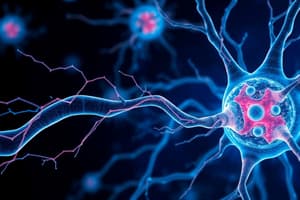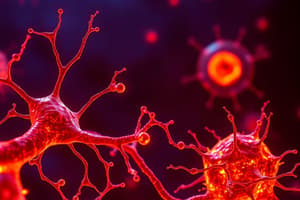Podcast
Questions and Answers
What is the primary role of ligands in cell signaling?
What is the primary role of ligands in cell signaling?
- To degrade signaling molecules after use
- To form structural components of the cell membrane
- To inhibit the activity of receptors
- To bind to and activate receptors (correct)
Which type of signaling involves the release of hormones into the bloodstream?
Which type of signaling involves the release of hormones into the bloodstream?
- Endocrine signaling (correct)
- Paracrine signaling
- Local signaling
- Synaptic signaling
What is the first stage of signal transduction in cell signaling?
What is the first stage of signal transduction in cell signaling?
- Response
- Propagation
- Transduction
- Reception (correct)
What distinguishes synaptic signaling from other forms of signaling?
What distinguishes synaptic signaling from other forms of signaling?
Which type of receptor is specifically embedded in the plasma membrane?
Which type of receptor is specifically embedded in the plasma membrane?
Which of the following accurately describes long-distance signaling in plants?
Which of the following accurately describes long-distance signaling in plants?
What is the main function of receptors in cell signaling?
What is the main function of receptors in cell signaling?
What is the significance of insulin in endocrine signaling?
What is the significance of insulin in endocrine signaling?
What initiates the signal transduction pathway when a ligand binds to a GPCR?
What initiates the signal transduction pathway when a ligand binds to a GPCR?
Which type of receptors can directly influence gene expression upon ligand binding?
Which type of receptors can directly influence gene expression upon ligand binding?
What occurs during transduction in cellular signaling?
What occurs during transduction in cellular signaling?
What is the function of second messengers in the signal transduction pathway?
What is the function of second messengers in the signal transduction pathway?
What happens during phosphorylation?
What happens during phosphorylation?
Which process typically deactivates a protein in signal transduction?
Which process typically deactivates a protein in signal transduction?
In the context of cellular signaling, what is the final stage called?
In the context of cellular signaling, what is the final stage called?
What type of receptors act as gates controlled by ligands to allow ions to flow into or out of the cell?
What type of receptors act as gates controlled by ligands to allow ions to flow into or out of the cell?
What is the role of G Protein-Coupled Receptors (GPCRs) in cellular signaling?
What is the role of G Protein-Coupled Receptors (GPCRs) in cellular signaling?
Which of the following best describes the process of homeostasis?
Which of the following best describes the process of homeostasis?
What happens when a ligand binds to an Ion Channel Receptor?
What happens when a ligand binds to an Ion Channel Receptor?
Which of the following is NOT a key word associated with homeostasis?
Which of the following is NOT a key word associated with homeostasis?
What is an example of a cellular response initiated by a signal?
What is an example of a cellular response initiated by a signal?
How can signaling pathways be altered?
How can signaling pathways be altered?
What is the function of receptors in the context of homeostasis?
What is the function of receptors in the context of homeostasis?
What occurs to GDP when a G Protein-Coupled Receptor is activated?
What occurs to GDP when a G Protein-Coupled Receptor is activated?
What is the main purpose of the cell cycle?
What is the main purpose of the cell cycle?
How is DNA organized within the cell nucleus?
How is DNA organized within the cell nucleus?
What is the most compact form of DNA during cell division?
What is the most compact form of DNA during cell division?
What are sister chromatids?
What are sister chromatids?
Which phase of the cell cycle is primarily responsible for DNA replication?
Which phase of the cell cycle is primarily responsible for DNA replication?
What happens to chromatin during cell division?
What happens to chromatin during cell division?
What is the structure of DNA in its relaxed form?
What is the structure of DNA in its relaxed form?
Why is it important for DNA to be compacted into chromosomes during cell division?
Why is it important for DNA to be compacted into chromosomes during cell division?
What occurs during the S Phase of the cell cycle?
What occurs during the S Phase of the cell cycle?
What primarily happens in the G2 Phase of the cell cycle?
What primarily happens in the G2 Phase of the cell cycle?
Which statement is true about the Anaphase of mitosis?
Which statement is true about the Anaphase of mitosis?
What is the role of the mitotic spindle during mitosis?
What is the role of the mitotic spindle during mitosis?
In which phase does cytokinesis occur?
In which phase does cytokinesis occur?
How does cytokinesis differ between animal and plant cells?
How does cytokinesis differ between animal and plant cells?
What is the purpose of cell cycle regulation?
What is the purpose of cell cycle regulation?
Which phase of mitosis is characterized by the disappearance of the nucleoli?
Which phase of mitosis is characterized by the disappearance of the nucleoli?
Flashcards are hidden until you start studying
Study Notes
Overview of Cell Signaling
- Cell signaling is a process that allows cells to communicate and respond to their environment.
- Crucial for numerous vital functions - growth, differentiation, and metabolism.
- Signal transduction involves three core stages: reception, transduction, and response.
Reception
- The first stage in cell signaling is reception. Here, a signaling molecule (ligand) binds to a receptor on the target cell's surface or inside the cell.
- Ligands are signaling molecules that can be proteins, peptides, amino acids, steroids, or other types of molecules.
- Receptors are proteins that receive the signaling molecules; they can be located on the plasma membrane or intracellularly.
Types of Receptors
- Plasma membrane receptors are embedded in the cell membrane and bind to ligands that cannot cross the membrane. Examples include G protein-coupled receptors (GPCRs) and ion channel receptors.
- GPCRs are a large family of receptors that work with G proteins.
- Ion channels act as gates that open or close in response to a ligand, allowing ions to flow into or out of the cell.
- Intracellular receptors are found inside the cell, in the cytoplasm or nucleus. They bind to ligands that can cross the cell membrane, such as steroid hormones.
Conformational Change
- When a ligand binds to its receptor, it triggers a change in the receptor's shape (conformational change).
- This initiates the signal transduction cascade, setting off a series of events inside the cell.
Transduction
- Transduction converts the extracellular signal (ligand binding) into an intracellular signal through a series of steps often involving multiple molecules.
- Phosphorylation and dephosphorylation are key processes:
- Phosphorylation adds a phosphate group to a protein, typically using kinases, usually activating the protein.
- Dephosphorylation removes a phosphate group, typically using phosphatases, usually deactivating the protein.
- Amplification via second messengers, small molecules that propagate the signal inside the cell, plays an important role. Cyclic AMP (cAMP), produced in response to a signal, activates other proteins to amplify the signal.
Response
- The final stage, response, involves the transduced signal triggering a specific cellular activity.
- The signal can alter cellular processes, leading to changes in:
- Gene expression
- Enzyme activity
- Cell behavior
- Cell division
- Differentiation
- Initiation of apoptosis (programmed cell death)
- Secretion of hormones or other signaling molecules.
Important Receptors in Signal Transduction
- G Protein-Coupled Receptors (GPCRs):
- Interact with G proteins to transmit signals.
- Ligand binding activates a G protein, causing GDP to become GTP.
- The activated G protein can bind and activate an enzyme.
- Signal amplification leads to a cellular response.
- Ion Channel Receptors:
- Open or close in response to ligand binding, allowing ions to move across the cell membrane, changing the cell's electrical potential and triggering a response.
- Located in the plasma membrane.
- Important in the nervous system.
Introduction to Homeostasis
- Homeostasis is the process by which living organisms maintain a stable internal environment despite external changes.
- Crucial for proper cell function and overall organism health.
Set Points and Stimulus
- Set points are the ideal values or ranges that the body tries to maintain for various physiological conditions, such as temperature, pH, and glucose levels.
- A stimulus is any change in the environment that can trigger a physical or behavioral response, for example, an increase in body temperature due to exercise.
Receptor/Sensor
- A receptor/sensor detects the stimulus. Temperature sensors in the skin detect changes in external temperature.
Cell Cycle
- The cell cycle is a series of stages that a cell goes through to grow and divide, essential for growth, tissue repair, and reproduction.
- Encompasses accurate replication and distribution of genetic material to daughter cells.
DNA Organization
- DNA double helix - The most relaxed form of DNA, coiled into a spiral shape. It carries genetic information in the sequence of its bases (adenine, thymine, cytosine, and guanine).
- Histones and Nucleosomes - To fit inside the cell nucleus, DNA wraps around proteins called histones, forming nucleosomes. Each nucleosome comprises a DNA segment wound around eight histone proteins, aiding DNA organization and regulating accessibility for processes like transcription and replication.
- Chromatin - Nucleosomes coil and stack together to form chromatin, a more compact and organized form of DNA, still relaxed compared to chromosomes.
- Chromosomes - The most compact form of DNA organization occurs when chromatin condenses during cell division to form chromosomes. Each chromosome is a single, continuous DNA thread, tightly coiled and folded for efficient separation during cell division, preventing tangling and breakage.
Chromosome Replication and the Formation of the X Shape
- DNA Replication - During the S phase of interphase, the entire DNA molecule is duplicated, ensuring each new cell has the same genetic material.
- Sister Chromatids - After DNA replication, each chromosome comprises two identical DNA molecules called sister chromatids.
- S Phase (Synthesis) - DNA replication occurs, doubling the genetic material. Each chromosome is replicated to form two sister chromatids.
- G2 Phase (Second Gap) - The cell continues to grow and prepares for mitosis by producing necessary proteins and organelles.
M Phase (Mitosis)
- Prophase - Chromatin condenses into visible chromosomes. The nucleoli disappear. The mitotic spindle, made of microtubules, begins to form.
- Prometaphase - The nuclear envelope breaks down, and spindle fibers attach to the kinetochores of chromosomes.
- Metaphase - Chromosomes align at the cell's equatorial plane (metaphase plate). Microtubules are attached to each kinetochore.
- Anaphase - Sister chromatids are pulled apart to opposite poles of the cell by the spindle fibers. The cell elongates.
- Telophase - Nuclear envelopes reform around each set of separated sister chromatids (now individual chromosomes), and the chromosomes begin to decondense back into chromatin.
Cytokinesis
- The process of dividing the cytoplasm to form two distinct daughter cells.
- In Animals - A cleavage furrow forms, pinching the cell in two.
- In Plants - A cell plate forms down the middle of the cell and develops into a new cell wall, separating the two daughter cells.
Cell Cycle Regulation
- Ensures cells divide correctly, preventing errors that could lead to problems like cancer.
- Controls the timing and sequence of events in the cell cycle, ensuring cells only divide when ready and conditions are suitable.
Cell Cycle Regulation and Cancer
- Uncontrolled cell division, leading to the formation of tumors and potentially, cancer.
- Mutations in genes that regulate the cell cycle can lead to cancer.
Studying That Suits You
Use AI to generate personalized quizzes and flashcards to suit your learning preferences.




